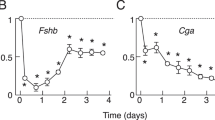Abstract
The present experiments were designed in order to elucidate the participation of the developing hypophysis in determining the changing sensitivity of gonadotrophins to gonadotropin-releasing hormone (GnRH) during ontogeny in the rat. To that end, we chose two well defined developmental ages that differ markedly in sexual and ontogenic characteristics of hypophyseal sensitivity to GnRH, 15 and 30 d. In order to study sex differences and the role of early sexual organization of the hypothalamus, experiments were carried out in males, females, and neonatally androgenized females (TP females). We evaluated (1) the characteristics of pituitary GnRH receptors, and (2) associated changes in GnRH-induced mobilization of intracellular Ca2+ (a second messenger involved in gonadotropins exocytosis).
We measured binding characteristics of the GnRH analog d-Ser(TBu)6-des-Gly10-GnRH ethylamide in pituitary homogenates. We found that K ds did not vary among the different sex groups. Total number and concentration of receptors decreased in the female rat from 15–30 d of age, whereas in the male and TP female, receptors/pituitary increased, and the concentration/mg tissue did not change. Also, at 30 days of age, males presented higher content and concentration of receptors than females, and higher content than TP females. In order to evaluate if developmental and sexual differences in pituitary sensitivity to GnRH might be expressed through variations in the intracellular Ca2+ signal, we studied the mobilization of intracellular Ca2+ induced by GnRH (1 × 10−8 to 1 × 10−11 M) in a suspension of dispersed pituitary cells in the six groups. In cells from 15-d-old females, Ca2+ response was greater than in 30-d-old females at the doses of 10−8 to 10−10 M, indicating that in the infantile female rat activation of highly concentrated GnRH receptors is reflected in an increase in signal transduction mediated by Ca2+. In males and in female rats androgenized at birth, there was also a decrease in the magnitude of intracellular Ca2+ mobilization induced by GnRH (10−8 to 10−10 M) from 15–30 d of age, even though the concentration of GnRH receptors did not change in the same period.
In conclusion, the present results suggest that high sensitivity to GnRH, which has been described in the female infantile rat, may be related to elevated concentration of hypophyseal receptors coupled to an increase of intracellular calcium response to GnRH, both parameters decreasing as the rat matures. In males, the greater sensitivity that has been described for GnRH at 30 d in comparison to 15 d is paralleled by an increase in the total number of GnRH receptors per pituitary (and not in their concentration), but not in an increase in the magnitude of Ca2+ mobilization induced by GnRH. On the other hand, neonatal sexual organization of the hypothalamus is involved in the differential expression of GnRH receptors, but does not modulate mobilization of intracellular Ca2+ induced by the decapeptide.
Similar content being viewed by others
References
Becu-Villalobos, D., Lacau-Mengido, I. M., and Libertun, C. (1990). Cell. Mol. Neurobiol. 10, 473–484.
Ojeda, S. R. and Urbanski, H. F. (1994). In: The Physiology of Reproduction. Knobil, E. and Neill, J. (eds.) Raven, New York, pp. 363–409.
Becu-Villalobos, D., Lacau de Mengido, I. M., and Libertun, C. (1989). Dev. Brain Res. 47, 181–186.
Ojeda, S. R., Jameson, H. E., and Mc Cann, S. M. (1977). Endocrinology 100, 440–451.
Debeljuk, L., Arimura, A., and Schally, A. V. (1972). Endocrinology 90, 585–589.
Aubert, M. L., Begeot, M., Winiger, B. P., Morel, G., Sizonenko, P. C., and Dubois, P. M. (1985). Endocrinology 116, 1565–1576.
Hompes, P. G. A., Vermes, I., Tilders, F. J. H., and Schoemaker, J. (1982). Neuroendocrinology 35, 8–12.
Jakubowski, M., Blum, M., and Roberts, J. L. (1991). Endocrinology 128, 2702–2708.
Dutlow, C. M., Rachman, J., Jacobs, T. W., and Millar, R. P. (1992). J. Clin. Invest. 90, 2496–2501.
Harter, D. E. and Ramirez, V. D. (1985). Neuroendocrinology 40, 476–482.
Dalkin, A. C., Bourne, G. A., Pieper, D. R., Regiani, S., and Marshall, J. C. (1981). Endocrinology 108, 1658–1664.
Chan, V., Clayton, R., Knox, G., and Catt, K. J. (1981). Endocrinology 108, 2086–2092.
Dorner, G. (1981). Vitam. Horm. 38, 325–381.
Stojilkovic, S. S., Reinhart, J., and Catt, K. J. (1994). Endocr. Rev. 15, 462–499.
Ortmann, O., Stojilkovic, S. S., Cesnjaj, M., Emons, G., and Catt, K. J. (1992). Endocrinology 131, 1565–1568.
Ortmann, O., Merelli, F., Stojilkovic, S. S., Schultz, K. D., Emons, G., and Catt, K. J. (1994). J. Steroid Biochem. Mol. Biol. 48, 47–54.
Debeljuk, L., Arimura, A., and Schally, A. V. (1972). Endocrinology 90, 1499.
Naish, S. J., Brawer, J., Robaire, B., and Ruf, K. B. (1986). Biol. Reprod. 34, 549–557.
Duncan, J. A., Dalkin, A. C., Barkan, A., Regiani, S., and Marshall, J. C. (1983). Endocrinology 113, 2238–2236.
Fink, G. and Henderson, S. R. (1977). J. Endocrinol. 73, 157–164.
Barraclough, C. A. and Turgeon, J. L. (1974). In: Endocrinologie Sexuelle de la Periode Perinatale. Forest, M.G. and Bertrand, J. (eds.) INSERM, Paris, pp. 339–357.
Chiappa, S. A. and Fink, G. (1977). J. Endocrinol. 73, 157–164.
Chen, H. T. (1988). Mol. Cell Endocrinol. 57, 33–39.
Tomic, M., Cesnjaj, M., Catt, K. J., and Stojilkovic, S. S. (1994). Endocrinology 135, 1762–1771.
Nishizaki, T., Walent, J. H., Kowalchyk, J. A., and Martin, T. F. J. (1992). J. Biol. Chem. 267, 23,972–23,981.
Stojilkovic, S. S., Stutzin, A., Izumi, S.-I., Dufour, S., Torsello, A., Virmani, et al. (1990). New Biol. 3, 272–283.
Chamson-Reig, A., Lux-Lantos, V., Tesone, M., and Libertun, C. (1997). Endocrine. 6, 1–7.
Attardi, B. and Happe, H. K. (1986). Endocrinology 119, 274–283.
Anderson, J. M., Yasumoto, T., and Cronin, M. J. (1987). Life Sci. 103, 249–257.
Naor, Z. (1990). Endocr. Rev. 11, 326–353.
Grynkiewicz, G., Poenie, M., and Tsien, R. Y. (1985). J. Biol. Chem. 260, 3440–3450.
Author information
Authors and Affiliations
Corresponding author
Rights and permissions
About this article
Cite this article
Lacau-Mengido, I.M., Iglesias, A.G., Lux-Lantos, V. et al. Ontogenic and sexual differences in pituitary GnRH receptors and intracellular Ca2+ mobilization induced by GnRH. Endocr 8, 177–183 (1998). https://doi.org/10.1385/ENDO:8:2:177
Received:
Revised:
Accepted:
Issue Date:
DOI: https://doi.org/10.1385/ENDO:8:2:177




